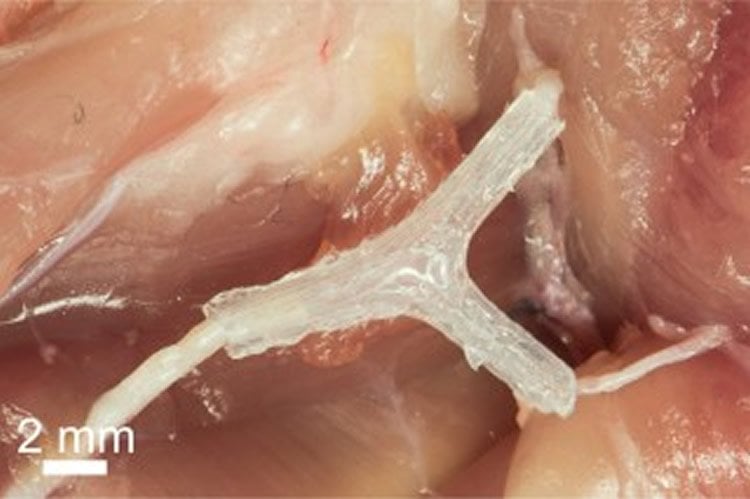Research could help more than 200,000 people annually who suffer from nerve injuries or disease.
A national team of researchers has developed a first-of-its-kind, 3D-printed guide that helps regrow both the sensory and motor functions of complex nerves after injury. The groundbreaking research has the potential to help more than 200,000 people annually who experience nerve injuries or disease.
Collaborators on the project are from the University of Minnesota, Virginia Tech, University of Maryland, Princeton University, and Johns Hopkins University.
Nerve regeneration is a complex process. Because of this complexity, regrowth of nerves after injury or disease is very rare, according to the Mayo Clinic. Nerve damage is often permanent. Advanced 3D printing methods may now be the solution.
In a new study, published today in the journal Advanced Functional Materials, researchers used a combination of 3D imaging and 3D printing techniques to create a custom silicone guide implanted with biochemical cues to help nerve regeneration. The guide’s effectiveness was tested in the lab using rats.
To achieve their results, researchers used a 3D scanner to reverse engineer the structure of a rat’s sciatic nerve. They then used a specialized, custom-built 3D printer to print a guide for regeneration. Incorporated into the guide were 3D-printed chemical cues to promote both motor and sensory nerve regeneration. The guide was then implanted into the rat by surgically grafting it to the cut ends of the nerve. Within about 10 to 12 weeks, the rat’s ability to walk again was improved.

“This represents an important proof of concept of the 3D printing of custom nerve guides for the regeneration of complex nerve injuries,” said University of Minnesota mechanical engineering professor Michael McAlpine, the study’s lead researcher. “Someday we hope that we could have a 3D scanner and printer right at the hospital to create custom nerve guides right on site to restore nerve function.”
Scanning and printing takes about an hour, but the body needs several weeks to regrow the nerves. McAlpine said previous studies have shown regrowth of linear nerves, but this is the first time a study has shown the creation of a custom guide for regrowth of a complex nerve like the Y-shaped sciatic nerve that has both sensory and motor branches.
Specialized 3D printing is used to create a first-of-its-kind customized nerve regeneration guide with incorporated biochemical cues to promote both sensory and motor growth nerve regrowth. The red dots represent cues for motor growth the green dots represent cues for sensory regrowth. This research was led by University of Minnesota mechanical engineering professor Michael McAlpine.
“The exciting next step would be to implant these guides in humans rather than rats,” McAlpine said. In cases where a nerve is unavailable for scanning, McAlpine said there could someday be a “library” of scanned nerves from other people or cadavers that hospitals could use to create closely matched 3D-printed guides for patients.
In addition to McAlpine, major contributors to the research team include Blake N. Johnson, Virginia Tech; Xiaofeng Jia, University of Maryland and Johns Hopkins University; and Karen Z. Lancaster, Esteban Engel, and Lynn W. Enquist, Princeton University.
Funding: This research was funded by grants from the National Institutes of Health, the Defense Advanced Research Projects Agency, the Maryland Stem Cell Research Fund, and the Grand Challenges Program at Princeton University.
Source: Rhonda Zurn – University of Minnesota
Image Credit: The image is credited to the researchers/University of Minnesota
Video Source: The video is available at the UMN College of Science and Engineering YouTube page
Original Research: Abstract for “3D Printed Anatomical Nerve Regeneration Pathways” by Blake N. Johnson, Karen Z. Lancaster, Gehua Zhen, Junyun He, Maneesh K. Gupta, Yong Lin Kong, Esteban A. Engel, Kellin D. Krick, Alex Ju, Fanben Meng, Lynn W. Enquist, Xiaofeng Jia and Michael C. McAlpine in Advanced Functional Materials. Published online September 18 2015 doi:10.1002/adfm.201501760
Abstract
3D Printed Anatomical Nerve Regeneration Pathways
A 3D printing methodology for the design, optimization, and fabrication of a custom nerve repair technology for the regeneration of complex peripheral nerve injuries containing bifurcating sensory and motor nerve pathways is introduced. The custom scaffolds are deterministically fabricated via a microextrusion printing principle using 3D models, which are reverse engineered from patient anatomies by 3D scanning. The bifurcating pathways are augmented with 3D printed biomimetic physical cues (microgrooves) and path-specific biochemical cues (spatially controlled multicomponent gradients). In vitro studies reveal that 3D printed physical and biochemical cues provide axonal guidance and chemotractant/chemokinetic functionality. In vivo studies examining the regeneration of bifurcated injuries across a 10 mm complex nerve gap in rats showed that the 3D printed scaffolds achieved successful regeneration of complex nerve injuries, resulting in enhanced functional return of the regenerated nerve. This approach suggests the potential of 3D printing toward advancing tissue regeneration in terms of: (1) the customization of scaffold geometries to match inherent tissue anatomies; (2) the integration of biomanufacturing approaches with computational modeling for design, analysis, and optimization; and (3) the enhancement of device properties with spatially controlled physical and biochemical functionalities, all enabled by the same 3D printing process.
“3D Printed Anatomical Nerve Regeneration Pathways” by Blake N. Johnson, Karen Z. Lancaster, Gehua Zhen, Junyun He, Maneesh K. Gupta, Yong Lin Kong, Esteban A. Engel, Kellin D. Krick, Alex Ju, Fanben Meng, Lynn W. Enquist, Xiaofeng Jia and Michael C. McAlpine in Advanced Functional Materials. Published online September 18 2015 doi:10.1002/adfm.201501760






